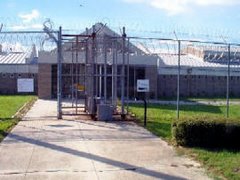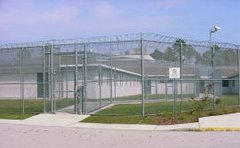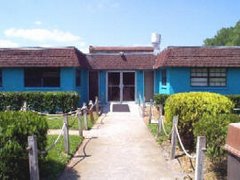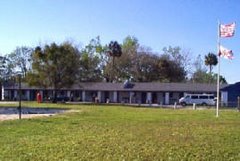June 9, 2007
Juvenile facilities rated among state's worst
Audits show rotting boards and safety problems are among the issues in Northeast Florida.
By DEIRDRE CONNER, The Times-Union
Northeast Florida facilities for juvenile offenders are rife with unacceptable problems, from crumbling buildings to shoddy treatment, according to state audits putting them among the worst in Florida.
Seven of the region's eight centers are minimal or failing, the audits show. The one exception, Hastings Youth Academy in St. Johns County, hasn't had a thorough state review since 2005.
Statewide, only a quarter of residential programs were ranked as minimal or failing in 2006.
Among the common problems found at the teen prisons here were moldy and crumbling buildings, falsified records and inadequate treatment plans. The state also found centers at which teachers fear for their safety, where youth were improperly punished after an alleged institution-wide insurrection, and where pregnant girls didn't get prenatal care.
When state Department of Juvenile Justice's Bureau of Quality Assurance auditors visited the Duval Halfway House, known in the past as the Duval Juvenile Residential Facility, they called the condition of the bedrooms and bathrooms "deplorable." They found rotting boards, holes in the wall and reports of rats on the property.
The 28 youths at the halfway house are kept in a former motel on Philips Highway. According to the review, the buildings were 80 years old and either need major renovation or should be torn down completely.
Those findings weren't anything new, though. Despite requesting money to fix the facility, its superintendent and the regional officials have been rebuffed year after year, reviewers wrote.
It's the same at the Nassau Juvenile Residential Facility in Fernandina Beach, where 37 fire violations were found. The building is "structurally challenged inside and out," the audit said, and the non-profit foundation running it has no financial means to fix it.
The state itself budgeted $1 million for such capital projects statewide this year.
A facility on Lannie Road, known as the Tiger Serious Habitual Offender Program, failed the state review this spring. The program, which houses 24 high-risk males, is under investigation because a staff member was accused of giving marijuana, Ecstasy and Xanax to seven youths. According to the audit, it has an ongoing problem with youths having contraband. During the past year, auditors said, there have been numerous reports of excessive or unnecessary force, improper staff conduct and youths getting violent with one another and with the staff.
Depending on their crime, young offenders can land at one of about 100 residential programs scattered throughout the state. The state spent $291 million for the programs in fiscal year 2005-06.
It's hard to know how some, like the Hastings Youth Academy, are doing because they haven't been checked in years. That's because a good rating ensured a reprieve from audits. The number of such programs tripled from 1997 to 2005, according to a Bureau of Quality Assurance report, which at the time heralded the news as a good thing.
This year, all the department's facilities will be audited, regardless of scores.
Auditors also won't be giving them advance notice like before.
"They wanted to make sure they got an accurate assessment," said Kimberly Griffin, a spokeswoman for the department.
Walter McNeil is the Department of Juvenile Justice's third secretary in three years and the second since 2004 to take over after a string of abuse scandals.
Amanda Ostrander, a spokeswoman for the advocacy group Children's Campaign, said it's encouraging to see that McNeil changed the department's mission to include caring for troubled youth. Previously, she said, it simply sought only to protect public safety.
Although McNeil has taken some steps toward reform since being appointed in January, Ostrander said, funding for the department has been cut.
"Providers are in crisis, and prices keep going up," she said. "It almost seems that those issues continue not to be a priority for the Legislature."
As early as December 2003, the Legislature's investigative branch slammed Juvenile Justice for the reviews. It said the department gave acceptable ratings to places with clear problems, such as the Florida Institute for Girls in West Palm Beach, where a grand jury investigated alleged sexual and physical abuse.
The Bay County Boot Camp, where seven guards and a nurse were charged with aggravated manslaughter in the death of 14-year-old Martin Lee Anderson in January 2006, earned a "commendable" rating in its last audit in 2004. The camp has since closed.
If the scores issued this spring of a half-dozen local programs are any indication, facilities may be judged more stringently than in the past.
That's a good thing, said Michael O'Loughlin, who directs alternative programs for the St. Johns County school system. The district sends teachers to the Hastings Youth Academy, where the average stay is six months to a year, as well as the St. Johns Juvenile Correctional Facility, a longer-term residential facility for high-risk sex offenders.
The educational programs are audited every year, he said, and the institutions should be, too.
"I think it's important we have a good idea of what's going on inside these facilities," O'Loughlin said. "It's a population that's otherwise easily written off."
deirdre.conner@jacksonville.com, (904) 359-4504
--------------------------------------------------------------------------------
INSIDE Breakdown of the area's eight juvenile facilities. A-8
--------------------------------------------------------------------------------
PROBLEMS NOTED
St. Johns Juvenile Correctional Facility
- Significant staff turnover and shortages.
- Workers are supposed to check rooms every 10 minutes, but videotape shows they falsified log books.
- Nine in 10 workers reviewed were hired before the program received preliminary background checks.
- During review period, team members observed lack of good order or control, with staff ignoring bad behavior in some cases. Youths were improperly punished.
Duval Halfway House
- Reviewers believe the youths' safety and health are jeopardized because of the building's structural problems.
- Youths are at risk because the facility was not screening them for suicide risk and one youth with suicide concerns was seen wandering the facility by himself.
- Wires hanging from the ceiling and bathrooms that reeked of urine.
Nassau Juvenile Residential Facility
- Building is structurally challenged inside and out, with rotting wood and holes in the wall.
- Reviewers found a knife cabinet unsecured in the kitchen and debris littered on the grounds, including glass, old batteries and inoperable lawnmowers.
- Thirty-seven fire violations.
- Insufficient staff checks, with youths seen on video running in and out of their rooms into other youths' rooms and roaming the hallways.
White Foundation Family Homes
- Not all severe and serious incidents were reported, including an arrest and an allegation of physical abuse. When reviewers followed up, all incidents were reported.
- A problem with escapes.
- Pregnant girls did not get proper prenatal care.
STEP (Outward Bound)
- Program didn't properly log incident reports.
- Three escapes since last review.
TigerSHOP
- Workers are supposed to check rooms every 10 minutes, but videotape showed they falsified log books and also falsified a medical file.
- Program is under investigation for a worker accused of taking seven youths out in the courtyard and giving them marijuana, Ecstasy and Xanax. The worker, who has been dismissed, was already under investigation after reports of taking 13 youths outside to supervise them alone.
- Unkempt facilities with objects lodged in the razor wire and floor stripping coming up.
- Program is not completing suicide assessments or follow-up assessments of suicide risk.
- Improper staff conduct, use of excessive/unnecessary force and multiple youth-on-youth assaults, plus a continuous problem with youth having contraband.
Impact Halfway House
- Workers are supposed to check rooms every 10 minutes, but videotape shows them falsifying log books. One night, checks weren't made for more than hours while a staff member apparently slept.
- Better dental care needed.
Hastings Youth Academy
(not reviewed since 2005)
- Staff reportedly cursed at youths and acted unprofessionally, and youths said they didn't break up fights fast enough.
- Workers and youths reported there had been gang activity in the facility during the past year.
- About half of the toilets were not in good working order.
Subscribe to:
Post Comments (Atom)








No comments:
Post a Comment